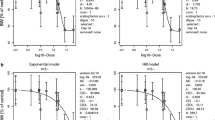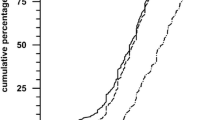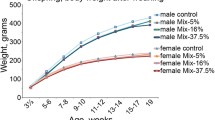Conclusions
The levels of o,p′-DDT fed in this experiment were considerably above those likely to be encountered in accidental feed adulteration or through careless use of the insecticide. Even though these experiments included the critical periods of reproductive maturation and were extended through two pregnancies, no adverse effect on female reproduction could be determined. Since o,p′-DDT is the most estrogenically potent of the isomers or metabolic analogs of DDT, these experiments serve to indicate levels of exposure that can be safely tolerated throughout growth, pregnancy, and lactation. Further, since technical DDT contains only 15–20% of the o,p′-isomer, by extrapolation it would be expected that daily amounts as high as 1 gram of the technical insecticide preparation (80–85%, p,p′-DDT) could be ingested without deleterious effects on reproduction, except for the physiological effects of so large a dose.
As judged from these experiments on a small laboratory rodent, our results indicate that o,p′-DDT, an estrogenically active pesticide, does not adversely affect reproduction in mammals.
Similar content being viewed by others
References
Bitman, J., Cecil, H. C., Harris, S. J., and Fries, G. F. Science 162, 371 (1968)
Bitman, J. Agr. Sci. Rev. 7, 7 (1969)
Levin, W., Welch, R. M., and Conney, A. H. Fed. Proc. 27, 649 (1968)
Welch, R. M., Levin, W., and Conney, A. H. Toxicol. Appl. Pharmacol. 14, 358 (1969)
Wrenn, T. R., Wood, J. R., Fries, G. F., and Bitman, J. Bull. Environ. Contam. & Tox. 5, 61 (1970)
Seifter, S., Dayton, S., Novic, B., and Muntwyler, E. Arch. Biochem. 25, 191 (1950)
Association of Official Agricultural Chemists, “Changes in Official Methods of Analysis”, J. Assoc. Offic. Agr. Chem. 49, 222 (1966)
Fries, G. F., Marrow, G. S., and Gordon, C. H. J. Agr. & Food Chem. 17, 860 (1969)
Ottoboni, A. Toxicol. Appl. Pharmacol. 14, 74 (1969)
Klein, A. K., Laug, E. P., Datta, P. R., Watts, J. O., and Chen, J. T. J. Assoc. Offic. Agr. Chem. 47, 1129 (1964)
Klein, A. K., Laug, E. P., Datta, P. R., and Mendel, J. L. J. Am. Chem. Soc. 87, 2520 (1965)
Bitman, J., Cecil, H. C., Harris, S. J., and Fries, G. F. Nature 224, 44 (1969)
Bitman, J., Cecil, H. C., Harris, S. J., and Fries, G. F. J. Agr. & Food Chem. (In press) (1971)
Hayes, W. J., Jr. In DDT Insecticides Vol. II (P. Müller Ed., Birkhäuser Verlag, Basel), p. 151 (1959)
Laben, R. C., Archer, T. E., Crosby, D. G., and Peoples, S.A. J. Dairy Sci. 48, 701 (1965)
Witt, J. M., Whiting, F. M., and Brown, W. H. In Organic Pesticides in the Environment, American Chemical Society p. 99 (1966)
Ottoboni, A. and Ferguson, J. I. Toxicol. Appl. Pharmacol. 15, 56 (1969)
Author information
Authors and Affiliations
Rights and permissions
About this article
Cite this article
Wrenn, T.R., Weyant, J.R., Fries, G.F. et al. Effect of several dietary levels of o,p′-DDT on reproduction and lactation in the rat. Bull. Environ. Contam. Toxicol. 6, 471–480 (1971). https://doi.org/10.1007/BF01684371
Issue Date:
DOI: https://doi.org/10.1007/BF01684371




